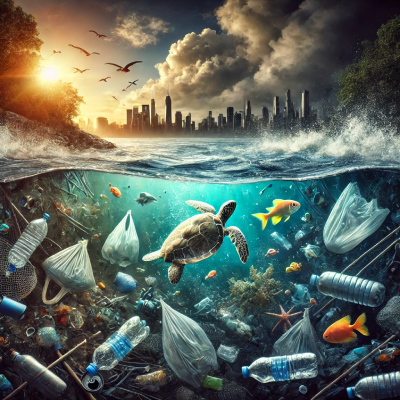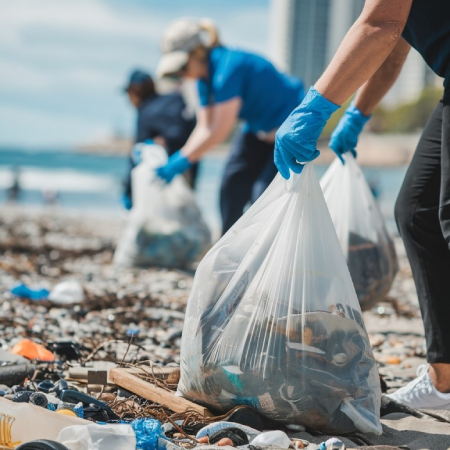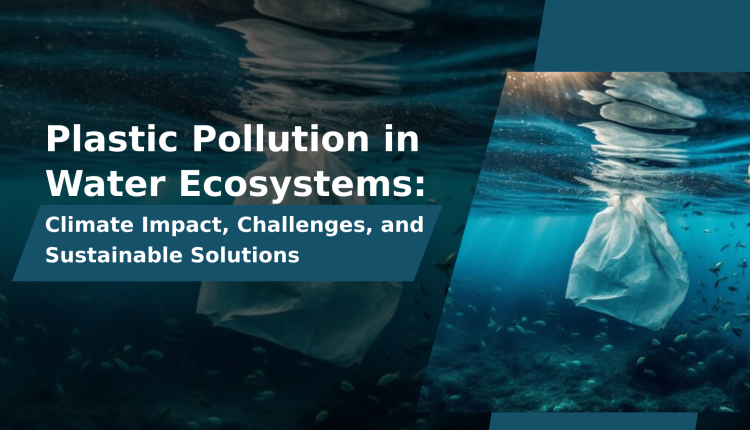Plastic pollution is a critical environmental issue, especially in aquatic ecosystems. Marine and freshwater bodies face increasing contamination from plastic waste. This pollution threatens biodiversity, water quality, and global climate stability. Plastic pollution in water ecosystems severely impacts aquatic life and the environment. The link between plastic pollution and climate change worsens environmental degradation. This blog explores plastic pollution’s impact, its connection to climate change, and innovative solutions to this crisis.
The Impact of Plastic Pollution on Marine and Freshwater Ecosystems
1. Threats to Aquatic Life and Biodiversity
Plastics in water—macroplastics to microplastics—devastate marine and freshwater organisms. Wildlife mistake plastic for food, leading to ingestion, malnutrition, and death. Kühn and van Franeker (2020) report over 700 marine species are affected by plastic pollution. Seabirds, fish, and marine mammals suffer entanglement or ingestion.

2. Microplastics and Water Contamination
Microplastics, plastic particles smaller than 5mm, are pervasive in marine and freshwater ecosystems, increasing plastic pollution in water ecosystems. These particles come from degraded plastics or direct product releases. Research shows microplastics transport persistent organic pollutants (POPs) and heavy metals. This increases aquatic toxicity.
3. Disruption of Aquatic Food Chains
Microplastic ingestion affects plankton, the base of aquatic food webs. Consumed microplastics bioaccumulate, biomagnify, and reach humans through seafood. Long-term health and ecological effects remain under investigation.

Plastic Pollution and Climate Change: The Hidden Connection
1. Greenhouse Gas Emissions from Plastic Production and Degradation
Plastic production relies on fossil fuels, significantly increasing greenhouse gas emissions. The plastic life cycle emits about 850 million metric tons of CO₂ yearly. Degrading plastics release methane and ethylene, accelerating climate change.
2. Impacts on Oceanic Carbon Sequestration
Oceans absorb about 25% of global CO₂ emissions. Plastic pollution disrupts carbon sequestration by harming marine organisms. Microplastics hinder phytoplankton growth, reducing CO₂ absorption and affecting carbon cycles.
3. Interaction with Climate-Induced Extreme Weather Events
Extreme weather worsens plastic pollution, spreading plastic waste widely. Floods transport debris to oceans, increasing contamination. Heat accelerates plastic breakdown, releasing toxic chemicals.
Innovative Solutions for Reducing Plastic Pollution in Water
1. Biodegradable and Alternative Materials
Biodegradable plastics and alternatives like algae-based packaging offer promising solutions. Bioplastics from renewable sources reduce plastic dependency and environmental persistence.
2. Advanced Wastewater Treatment Technologies
Current wastewater plants struggle to remove microplastics. Nanofiltration and bio-based adsorbents improve microplastic filtration and reduce aquatic contamination.
3. Circular Economy and Plastic Waste Management
A circular economy reduces plastic waste by reusing and recycling. Extended producer responsibility (EPR) policies require manufacturers to manage plastic waste.
4. Community Engagement and Policy Interventions
Public awareness, clean-up efforts, and regulations are key to addressing plastic pollution. Governments must ban single-use plastics and promote sustainable consumption.

Conclusion
Plastic pollution threatens marine and freshwater ecosystems while worsening climate change. It releases greenhouse gases and disrupts carbon sequestration. Plastic pollution in water ecosystems harms biodiversity and global balance. Addressing this crisis requires innovation, policy reforms, and community action. By promoting sustainable alternatives, improving waste management, and encouraging global cooperation, we can protect aquatic ecosystems.
The Sustainable Water Management and Resource Adaptation (SWMRA) Conference brings together experts to tackle water sustainability and pollution. It fosters international collaboration, highlights solutions, and advances research. By uniting global leaders, SWMRA supports UN Sustainable Development Goal 6 (Clean Water and Sanitation).
For more details about the SWMRA Conference, visit:
https://www.ierek.com/events/sustainable-water-management-and-resource-adaptation-swmra-2nd-edition#introduction



